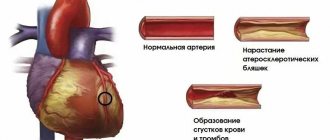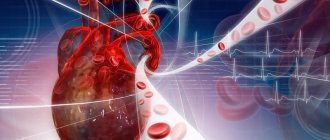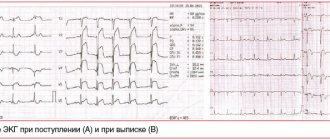Coronary heart disease (CHD), along with cancer, is not only a medical, but also a social problem. Massive studies of the 20th century made it possible to identify risk factors for coronary artery disease. These include heredity, age, excess body weight, physical inactivity, hypertension, diabetes and male gender. Among all the risk factors, there are avoidable ones, such as smoking, and irreparable ones.
Prevention of coronary heart disease can be primary and secondary. Primary prevention of coronary heart disease refers to the prevention of the occurrence and development of risk factors for diseases in people without clinical manifestations. Secondary prevention is aimed at eliminating risk factors that, under certain conditions, can lead to exacerbation or relapse of existing ischemic heart disease.
Risk factors for coronary heart disease
All risk factors for coronary heart disease can be divided into removable (modifiable) and irreducible (non-modifiable).
Unavoidable risk factors include:
- Age (men over 45 years old, women over 55 years old);
- Gender (male);
- Hereditary predisposition.
Other risk factors can be minimized. They include:
- Smoking;
- Lipid metabolism disorders (hypercholesterolemia);
- Physical inactivity and stress;
- Excessive nutrition;
- Diabetes;
- Arterial hypertension.
If a person has at least one risk factor, then the likelihood of developing IHD increases by 2-3 times. When several factors are combined, the risk of death from coronary heart disease increases up to 15 times. prevention of coronary artery disease is so important .
Risk factors for circulatory system diseases and their prevention
Risk factors for circulatory system diseases and their prevention
1. Biological (non-modifiable) factors:
- elderly age,
- male gender,
- genetic factors contributing to the occurrence
- - dyslipidemia,
- - hypertension,
- - glucose tolerance,
- - diabetes mellitus
- - obesity
2. Anatomical, physiological and metabolic features:
- arterial hypertension,
- dyslipidemia,
- obesity and the pattern of fat distribution in the body,
- diabetes
3. Behavioral factors:
- eating habits,
- smoking,
- physical activity,
- alcohol consumption,
- exposure to stress.
The presence of even one of the risk factors increases the mortality rate of men aged 50-69 years by 3.5 times, and the combined effect of several factors - by 5-7 times.
Currently, a distinction is made between primary, secondary and tertiary prevention of diseases of the circulatory system (hereinafter referred to as CVD). The first two types of prevention are consistent with previously put forward provisions, namely: primary prevention of coronary heart disease (hereinafter referred to as IHD) is the prevention of the development of the disease in healthy individuals and persons burdened with various risk factors, and secondary prevention is the prevention of the progression of the disease and the development of complications of the course of CHD. in people who already have this disease.
Tertiary prevention refers to the implementation of actions aimed at delaying the progression of heart failure (hereinafter referred to as HF). In heart failure, the relationship between traditional risk factors and disease outcome breaks down. The functional state of the left ventricle plays a decisive role. The onset of left ventricular remodeling is the starting point for tertiary prevention.
The main components of primary prevention are population strategy and individual prevention (high-risk strategy).
The population strategy, or mass prevention strategy, is to create a healthy lifestyle, which primarily involves reducing tobacco smoking, establishing a balanced diet, increasing physical activity for the entire population and improving the environment. These are, as a rule, government events that involve the involvement of not only and not so much the Ministry of Health, but other ministries and departments (Ministry of Sports and Tourism, Ministry of Agriculture, Ministry of Information, etc.).
Individual prevention (High-risk strategy) is the identification of individuals with high levels of risk factors (smoking, arterial hypertension, hypercholesterolemia, excess weight, low physical activity, etc.) and their correction.
The current recommendations “Prevention of Coronary Heart Disease in Clinical Practice”, developed by the working group of the European Society of Cardiology, the European Atherosclerotic Society and the European Society of Hypertension, emphasize the importance of assessing overall cardiovascular risk.
The priority for primary prevention, according to European guidelines, is healthy individuals who are at high risk of developing coronary artery disease or other atherosclerotic diseases due to a combination of risk factors, including smoking, high blood pressure and lipid levels (increased total cholesterol and low-lying lipoproteins). density (LDL), low high-density lipoprotein and high triglycerides, elevated blood glucose, family history of premature coronary disease or high hypercholesterolemia and other forms of dyslipidemia, hypertension or diabetes.
Secondary prevention should also include lifestyle changes (stop smoking, avoid second-hand smoke, eat rationally to lose weight, reduce blood pressure and cholesterol levels, control blood glucose, increase physical activity). If active lifestyle changes fail to achieve target levels of risk factors, drug therapy should be added. Patients with angina pectoris and those who have had a myocardial infarction should give preference to beta-blockers, and if they are not tolerated, long-acting calcium channel blockers.
ACE inhibitors should be prescribed to patients with significant left ventricular systolic dysfunction. Almost all patients are prescribed antiplatelet drugs such as aspirin 75 mg per day, etc. Simultaneous administration of aspirin and ACE inhibitors is undesirable.
If, with lifestyle changes, target cholesterol and LDL cholesterol levels are not achieved, lipid-normalizing drugs, primarily statins, must be prescribed. It is also necessary to correct high blood pressure and glucose levels.
The most unfavorable combination of risk factors is the so-called metabolic syndrome (MS), which is a complex of interrelated disorders of carbohydrate and fat metabolism, as well as the mechanisms of regulation of blood pressure and endothelial function. The basis of these disorders is a decrease in tissue sensitivity to insulin - insulin resistance. The main components of MS are abdominal-visceral obesity, hypertriglyceridemia, hyperinsulinemia and arterial hypertension. When these factors are combined, atherosclerosis develops at an accelerated rate.
Due to the particular aggressiveness of MS, it is called “deadly quartet”, “deadly sextet”, “syndrome X”, “insulin resistance syndrome”.
To diagnose MS, they most often resort to measuring waist circumference, determining the level of triglycerides in the blood serum and fasting insulin, and monitoring blood pressure.
When MS is detected, preventive and therapeutic measures should be aimed at the entire set of risk factors and include weight loss, adequate control of glycemia and dyslipidemia, and normalization of blood pressure. The management tactics for patients with hypertension and MS have a number of features:
- immediate initiation of treatment with antihypertensive drugs in combination with non-pharmacological measures (diet, physical activity);
- focus on achieving optimal or normal blood pressure (below 130/85 mm Hg), since it has been proven that stabilizing blood pressure at this level and below gives a real organoprotective effect;
- more frequent use of combinations of antihypertensive drugs, which is due to greater resistance to reducing high blood pressure in such patients.
If general measures fail to normalize carbohydrate metabolism, it is necessary to resort to medication to increase tissue sensitivity to insulin by using biguanides (metformin), β-glycosidase inhibitors (acarbose, miglitol), thiazolindiones (cyclitazone, engystol, pioglitazone, troglitazone). Sensitivity can also be increased by increasing tissue blood flow with the help of ACE inhibitors, β-blockers (doxazosin) and other drugs. The same should be done for hypertriglyceridemia: prescribe fibrates, nicotinic acid preparations, etc.
Tertiary prevention should be targeted specifically from the onset of left ventricular remodeling. This is the most important part of all preventive measures for CSD, since almost half of the hospitalizations of patients with cardiovascular pathology are for heart failure. The rate of re-hospitalization among patients with CHF within 3 months after discharge reaches 47%, within 6 months - 54%. The costs of treating patients with CHF exceed the costs of treating patients with the most common forms of cancer and myocardial infarction. Left ventricular function in such patients has a primary influence on the outcome of the disease. Low or normal blood pressure, elevated cholesterol and brain natriuretic peptide levels increase the risk of heart failure and are associated with increased mortality.
It has been proven that the main drugs that protect the myocardium are ACE inhibitors and beta blockers. It has now been practically established that aspirin has an adverse effect in the treatment of patients with CHF. Nothing is known yet about the safety and effectiveness of statins in patients with HF.
Currently, a multidisciplinary approach to the treatment of heart failure is generally accepted, the essence of which is to unite doctors and representatives of other specialties to comprehensively address the many medical, psycho-social, behavioral and financial problems faced by patients with heart failure and the doctors treating them.
One of the organized forms for the practical application of a multidisciplinary approach to the treatment of CHF is the heart failure clinic. It can be presented both as an inpatient unit and as a day hospital at an outpatient clinic facility, which has at its disposal the means for diagnosis, monitoring and the ability to provide adequate treatment.
The team that will be involved in the treatment of patients with CHF in heart failure clinics, according to LR Erhardt, should include a cardiologist or heart failure specialist, a specially trained nurse, a gerontologist, a social worker, a physiotherapist, a general practitioner, a psychologist, a nutritionist and clinical pharmacologist.
What goals need to be achieved in the fight against risk factors?
According to WHO, three main risk factors make the greatest contribution to the risk of sudden death: hypertension, hypercholesterolemia (dyslipidemia) and smoking.
Arterial hypertension (HTN) is often called the “mysterious and silent killer.” Mysterious - because in most cases the causes of the disease remain unknown, silent - because in many patients the disease is asymptomatic and they do not know about the presence of high blood pressure (BP) until any complication develops. In order to correctly determine the risk of developing arterial hypertension and, as a result, coronary artery disease, you need to know and control your blood pressure level, and, if necessary, undergo an examination that will help clarify disorders of carbohydrate and fat metabolism and the degree of damage to target organs (vessels, heart, kidneys) , brain).
Analysis of the study results showed that to diagnose target organ damage in our country, examination methods such as ultrasound of the brachiocephalic arteries (in 9% of patients, versus 24.1% in other countries), determination of microalbuminuria (in 0.7% of patients versus 10% in other countries), and 24-hour blood pressure monitoring is performed less frequently (in 8.9% of patients, versus 24.5% in European countries).
An analysis of prescribed antihypertensive therapy showed that treatment of patients with hypertension in the Republic of Belarus is carried out with modern drugs, in 80.4% combination therapy is prescribed, which is comparable to the results of treatment in other European countries. In our country, as well as in comparison countries, there is a low effectiveness of treatment of patients with hypertension with concomitant diabetes mellitus (the target level is achieved in only 10% of patients).
Dyslipidemia is an imbalance in the content of “bad” and “good” fat fractions in the blood towards an increase in “bad” and/or a decrease in “good” fats. “Bad” fats, an increased amount of which greatly increases the risk of developing atherosclerosis and coronary artery disease, include cholesterol, low- and very low-density lipids, and triglycerides. To the “good” fats, i.e. Preventing the development of CVD include high-density lipids. With the exception of a small number of people with hereditary hypercholesterolemia, cholesterol levels are generally associated with poor diet. A balanced diet requires eating plenty of fruits and vegetables, healthy breads, lean meats, fish and legumes, along with low- or no-fat foods.
Soft margarine, sunflower, corn, rapeseed or olive oil should be used. The total fat content should not exceed 30% of the total energy composition, and the saturated fat content should not exceed 1/3 of all fat consumed. Many years of clinical experience indicate the unique properties of omega-3 polyunsaturated fatty acids, which help reduce the risk of CVD and its complications. More than 30 years ago, a group of Danish researchers suggested that the low incidence of cardiovascular pathology among the Greenland Eskimos was associated with their high consumption of deep-sea fish and seafood.
In epidemiological comparative, prospective and clinical studies, it has been shown that the intake of omega-3 polyunsaturated fatty acids at a dose of 2-4 g per day, both with increased amounts of fish consumed and in the form of encapsulated fish oil, leads to the correction of dyslipidemia and reduces the risk of death in patients who have had myocardial infarction. The presence of dyslipidemia is determined by a doctor based on the results of a biochemical analysis of venous blood. If dyslipidemia is present, its correction begins with diet. If, with the help of diet and balanced nutrition, it is not possible to reduce the lipid spectrum within 3 months, and a person simultaneously has other risk factors, drug therapy is prescribed.
A balanced diet is a balanced, regular (at least 4 times a day) diet with limited salt intake. Research by scientists has shown that if you limit your salt intake, the risk of myocardial infarction and other heart events can be reduced by 25%. It is very useful to increase the consumption of foods containing potassium and magnesium (seaweed, raisins, beets, apricots, zucchini, pumpkin, buckwheat).
Healthy food choices
All individuals should receive professional advice on food choices and follow a diet that is associated with minimal risk of developing CVD.
General recommendations (determined according to cultural traditions):
- food should be varied, energy consumption should be optimal to maintain ideal weight;
- Consumption of the following foods should be encouraged: fruits and vegetables, whole grains and breads, low-fat dairy products, lean meats, fish;
- consume products containing fish oil and w-omega, which have special protective properties;
- the total fat content should not exceed 30% of the total energy composition, and the saturated fat content should not exceed a third of all consumed fats; the amount of cholesterol consumed should be less than 300 mg/day;
- with a low-calorie diet, saturated fats should be replaced partly with carbohydrates, partly with monounsaturated and polyunsaturated fats from vegetables and marine animals.
In the diet, it is recommended to limit the consumption of animal products rich in cholesterol and saturated fats: fatty meats, lard, butter, sour cream, egg yolk, fatty cheese, sausage, sausages, all offal, fish caviar, shrimp, squid. It is recommended to replace animal fat with vegetable fat, since the latter is rich in anti-atherogenic unsaturated fats. Polyunsaturated fats (PUFs) are found in the form of omega-6 linoleic acid in vegetable oil (sunflower, corn, cottonseed) and in the form of omega-3 alpha-linolenic acid in flaxseed and soybean oils. The minimum daily human need for essential linoleic acid is 2-6 g, which is equivalent to 10-15 g of sunflower oil (2-3 teaspoons).
Fish oil is rich in polyunsaturated omega-3 fatty acids (omega-3 PUFAs) - eicosapentaenoic acid and docosahexaenoic acid. Preference should be given to fish from the northern seas that contain a lot of omega-3 PUFAs (mackerel, sardines, tuna, salmon, mackerel, herring, halibut, etc.). It has been established that polyunsaturated fatty acids significantly reduce the level of TG and, to a lesser extent, total cholesterol. Other effects of omega-3 PUFA include its effect on blood pressure levels, suppression of thrombus formation and improvement of endothelial function. It has been established that the likelihood of developing coronary heart disease is reduced by at least 25-30% when eating fish 2-4 times a week.
Over the past decade, hydrogenated vegetable oils have been widely used in the diet. The level of trans isomers (harmful substances) in hard margarines can reach up to 60%. Trans isomers of unsaturated fatty acids are similar to saturated fatty acids in lipid metabolism. It has been proven that their consumption (more than 1%) increases the risk of development and progression of coronary heart disease due to a significant increase in the levels of total cholesterol and LDL cholesterol and a decrease in the concentration of HDL cholesterol. To prevent atherosclerosis, it is recommended to use only soft margarine, produced in tubes (margarine spread) and plastic boxes, with a low content of saturated fat and trans-isomers of fatty acids (FA) (less than 1%). Replacing butter with “soft” margarine reduces the risk of IHD by 10%. However, the amount of soft margarine consumed should be limited, spreading no more than 5 g on bread.
Typically, by limiting dietary cholesterol intake to 300 mg per day over time, it is possible to reduce its blood level by 10-15%, and by reducing total fat intake from 40 to 30% of the total caloric intake - by another 15-20%.
Another important principle of anti-atherogenic nutrition is increasing the consumption of plant-based foods that can bind and remove cholesterol from the body. In this regard, it is recommended to use:
— dietary fiber (at least 30 g per day); they are found in large quantities in fruits (pears, apples, oranges, peaches), berries (raspberries, strawberries, blueberries), vegetables (cauliflower, broccoli, green beans) and legumes (peas, lentils, beans);
- pectins (at least 15 g per day), which are found in fresh fruits (apples, plums, apricots, peaches), berries (black currants) and vegetables (carrots, beets);
— plant stanols (at least 3 g per day); they are contained in soybean and rapeseed oils, pine oil extracts; Recently, sterols/stanols, being plant lipids, have been shown to reduce LDL cholesterol levels in the blood by competitively inhibiting the absorption of cholesterol in the small intestine.
It has been proven that their regular use is accompanied by a decrease in the concentration of LDL cholesterol by 10-15%; Margarines and fermented milk products fortified with sterols/stanols are now available and may be a useful addition to a lipid-lowering (HL) diet or drug treatment for DLP.
To prevent atherosclerosis, it is recommended to eat more fruit - at least 400 g or 5 servings per day: 1 serving = 1 apple / 1 banana / 1 orange / 1 pear / 2 kiwi / 2 plums / 1 tablespoon of dried fruit / 1 large slice of melon or pineapple / 1 glass of juice. The amount of boiled or fresh vegetables in the diet should be at least 400 g (2 cups).
Basic principles of the diet recommended for the prevention of atherosclerosis and DLP:
1. regular consumption of a variety of vegetables and fruits (fresh vegetables for dessert);
2. the ratio between saturated, mono- and polyunsaturated fats should be 1:1:1;
3. moderate consumption of dairy products (skim milk, low-fat cheese and low-fat yogurt);
4. give preference to fish and poultry (without skin) over meat products;
5. from meat products, choose lean meat, without layers of fat;
6. consume no more than 2-3 eggs per week (the consumption of yolks is limited, but not the white, which can be unlimited).
Excess body weight increases the risk of developing coronary artery disease and other diseases associated with atherosclerosis. To estimate your weight, use a simple formula for determining your body mass index (weight (kg) / height (m2) = body mass index). If the body mass index is less than 25, this is the desired body weight; if more than 28 in women and 30 in men, we can talk about obesity. Moreover, the so-called central obesity (male type), when fat is deposited on the abdomen, is more dangerous. The presence of central obesity can be judged by waist circumference and the ratio of waist circumference to hip circumference. The risk of CVD increases in men with a waist circumference greater than 94 cm and, especially, with a circumference greater than 102 cm; in women, greater than 80 cm and 88 cm, respectively. The ratio of waist circumference to hip circumference in men is greater than 1.0 and in women greater than 0. 85 is a more accurate indicator of the central type of obesity. The most common causes of excess weight are family factors (some of which may be genetic, but more often reflect general eating habits), overeating, a diet high in fat and carbohydrates, and lack of physical activity. Overweight is most common among sections of society with lower cultural and educational levels, especially among women due to lack of a balanced diet.
Smoking is one of the main risk factors. Why is smoking dangerous? Because even one cigarette increases blood pressure for 15 minutes, and with constant smoking, vascular tone increases and the effectiveness of medications decreases. If a person smokes 5 cigarettes a day, this increases the risk of death by 40%, if one pack a day - by 400%, that is, the chances of dying are 10 times greater!
According to WHO, 23% of deaths from coronary heart disease are caused by smoking, reducing the life expectancy of smokers aged 35-69 years by an average of 20 years. Sudden death among people who smoke a pack of cigarettes or more per day is 5 times more common than among non-smokers. Smokers not only put their lives at risk, but also the lives of others (passive smoking increases the risk of coronary artery disease by 25-30%). After just 6 weeks of following a healthy lifestyle, dramatic changes in health occur, and among those who quit smoking, the risk of coronary heart disease is significantly reduced and after 5 years it becomes the same as for those who have never smoked.
Low physical activity contributes to the development of CVD 1.5-2 times more often than in people leading a physically active lifestyle. Walking at a brisk pace for half an hour a day can reduce the risk of heart disease by approximately 18% and stroke by 11%. For the prevention of CVD and health promotion, the most suitable physical exercises are those that involve regular rhythmic contractions of large muscle groups: fast walking, jogging, cycling, swimming, skiing, etc. The frequency of physical exercise should be at least 4-5 times a day. week, duration of classes is 30-40 minutes, including a warm-up and cool-down period. When determining the intensity of physical exercise acceptable for a particular patient, they proceed from the maximum heart rate (HR) after physical activity - it should be equal to the difference between the number 220 and the patient’s age in years. For people with a sedentary lifestyle without symptoms of coronary artery disease, it is recommended to choose an intensity of exercise at which the heart rate is 60-75% of the maximum. Recommendations for individuals with CAD should be based on clinical examination and exercise test results.
The Committee of the European Society of Cardiology has developed the main tasks for the prevention of CVD in a healthy person:
- systolic blood pressure below 140 mm Hg;
- no tobacco use;
— total cholesterol level below 5 mmol/l;
— low-density lipoprotein cholesterol below 3 mmol/l;
- walking 3 km a day or 30 minutes of any other moderate physical activity;
- daily use of at least 5 pieces of fruits and vegetables;
- Avoid obesity and diabetes.
The experience of multifactorial prevention of coronary artery disease carried out by the Republican Scientific and Practical Center "Cardiology" since 2000 at the population level in Minsk has shown that a decrease in the levels of risk factors in combination with active measures for secondary prevention is accompanied by a decrease in the incidence of myocardial infarction by 21%, cerebral stroke by 21%. 24%. At the same time, the practical implementation of preventive programs, which involves a set of measures to increase the population’s literacy in matters of a healthy lifestyle and resolve a number of social issues relating to a balanced diet, the organization of physical culture and health activities for the population, etc., requires the widespread involvement of republican and local government bodies.
Thus, to effectively prevent most cardiovascular diseases and their complications, you need to follow only 7 rules:
1. Monitor your blood pressure.
2. Control your cholesterol levels.
3. Eat right.
4. Exercise: A little is better than nothing.
5. Don’t start smoking, and if you smoke, try to quit, no matter how difficult it may seem.
6. Do not abuse alcoholic beverages.
7. Try to avoid prolonged stress.
In conclusion, even small lifestyle changes can slow down the aging of the heart. It's never too late to start living a healthy lifestyle. After a person develops signs of coronary artery disease, risk factors continue to act, contributing to the progression of the disease and worsening the prognosis, so their correction should be an integral part of treatment tactics.
Primary prevention of coronary heart disease
Primary prevention of IHD is carried out among people without clinical manifestations of the disease, that is, practically healthy. The main areas of primary prevention of coronary heart disease include:
- organization of rational nutrition,
- lowering cholesterol and blood sugar levels,
- body weight control,
- normalization of blood pressure,
- the fight against smoking and physical inactivity, as well as
- organizing the correct daily routine and alternating work and rest.
That is, prevention is aimed at eliminating modifiable risk factors and is not only a personal, but also a national problem.
Proper nutrition based on the principle of matching calories consumed with calories burned. The approximate diet of a thirty-year-old mental worker should contain no more than 3000 kcal, with protein should be 10-15%, carbohydrates (mostly complex) - at least 55-60%. As you age, you need to reduce your calorie intake by approximately 100-150 kcal every 10 years.
Scientists have long shown that lowering blood cholesterol levels can lead not only to preventing the development of atherosclerosis and coronary artery disease, but also to some regression of plaques already formed in the vessels. At the initial stage, hypercholesterolemia must be combated through diet; if there is no effect, medications (statins) may be used. This is especially important for people with irreparable risk factors for developing coronary heart disease. The same goes for normal blood glucose levels
To monitor body weight, doctors and nutritionists use an indicator called body mass index (BMI). This figure is obtained by dividing a person's weight in kilograms by the square of their height in meters. For example, with a height of 170 cm and a weight of 70 kg, the body mass index will be 24. Normal BMI values are in the range of 18.5-25.
Arterial hypertension is an independent risk factor for the development of coronary artery disease, therefore, at the first signs of an increase in pressure more than 140/90 mm Hg. it is necessary to contact a cardiologist to select therapy.
Smoking is not just a bad habit. It has been established that smoking even 1 cigarette a day leads to a 2-fold increase in the risk of death from coronary heart disease. That is why so many social policy programs are aimed at combating smoking.
It is not so easy to get a young healthy man to give up, say, smoking or eating fatty foods. Not everyone thinks about the future, and IHD, which can develop in 20-30 years, is not the best motivating factor. To make it easier for doctors to convey information about the primary prevention of coronary heart disease to the population, special tables of the absolute risk of developing coronary artery disease have been developed. These nomograms allow us to determine the risk of developing coronary artery disease now and by age 60 years. If, according to parameters (age, gender, smoking, systolic pressure, blood cholesterol concentration), the risk of developing IHD reaches 20%, then immediate intervention and correction of risk factors is necessary.
Prevention of cardiovascular diseases
Cardiovascular disease (CVD) is the leading cause of death worldwide: no other cause causes more deaths each year than CVD. Cardiovascular diseases are a group of diseases of the heart and blood vessels that include:
- coronary heart disease - a disease of the blood vessels that supply blood to the heart muscle;
- cerebrovascular disease - a disease of the blood vessels supplying blood to the brain;
-peripheral artery disease - disease of the blood vessels that supply blood to the arms and legs;
-rheumatic carditis - damage to the heart muscle and heart valves as a result of a rheumatic attack caused by streptococcal bacteria;
-congenital heart disease – deformations of the structure of the heart existing from birth;
-deep vein thrombosis and pulmonary embolism - the formation of blood clots in the leg veins, which can dislodge and move towards the heart and lungs.
Heart attacks and strokes are usually acute illnesses and occur primarily as a result of blockages in blood vessels that prevent blood from flowing to the heart or brain. The most common cause of this is the formation of fatty deposits on the inner walls of the blood vessels that supply blood to the heart or brain. Bleeding from a blood vessel in the brain or blood clots can also cause a stroke.
The first general signs of cardiovascular disease:
- accelerated heartbeat
- pain in the heart area
- dyspnea
- dizziness
Of course, some of these symptoms can also appear in other diseases, so to determine a specific disease of the cardiovascular system, you should take into account the presence of several signs at once and seek help from a specialist!
Coronary artery disease is characterized by insufficient oxygen supply to the heart due to narrowing or blockage of the arteries of the heart.
Symptoms of coronary artery disease:
- Dyspnea
- Arrhythmia
- Feeling of tightness in the heart area
- Increased sweating (cold)
- Aching pain in the arm, leg, under the shoulder blade, in the jaw area
- Unexplained feeling of fear, anxiety
A heart attack is a consequence of difficult-to-progress coronary heart disease. After a coronary artery is blocked, the blood supply to the heart is interrupted and necrosis of the heart muscle occurs.
Symptoms of a heart attack:
- Pain in the central part of the chest.
- Difficulty breathing
- Nausea, vomiting
- Numbness of part of the face, upper or lower extremities
- Dizziness, unsteadiness when walking
- Headache attack
- Fainting
- Memory loss
Atherosclerosis of cerebral vessels is damage to blood vessels by fatty or cholesterol plaques, resulting in a lack of blood supply to tissues.
The first signs of atherosclerotic manifestations:
- Headache
- Periodic noise sensations in the ears
- Decreased memory for recent events
- Sleep disturbance
- Suspiciousness
- Deterioration of motor coordination
- Tremor of the limbs and head
- Numbness of body parts
A complication of atherosclerosis can be a stroke.
Stroke is a critical disorder of the cerebral blood supply that occurs when a blood vessel is blocked by a blood clot, plaque (ischemic stroke) or when a blood vessel ruptures (hemorrhagic stroke). Sudden hemorrhage can occur with hypertension.
Symptoms of a stroke:
- Numbness, weakness of the facial muscles, upper or lower limbs
- Difficulties in pronunciation and understanding of speech
- Sudden decrease or loss of vision
- Strong headache
- Drowsiness
- Vomit
What are the risk factors for cardiovascular disease?
The main risk factors for heart disease and stroke are poor diet, physical inactivity, tobacco use and harmful use of alcohol. The effects of behavioral risk factors on an individual may include increased blood pressure, increased blood glucose, increased blood lipids, and overweight and obesity.
Quitting tobacco use, reducing salt intake, consuming fruits and vegetables, regular physical activity and avoiding harmful use of alcohol have been shown to reduce the risk of developing cardiovascular disease.
Prevention of cardiovascular diseases.
It is impossible to protect yourself from all risk factors, but everyone can reduce the likelihood of developing diseases. To prevent diseases of the cardiovascular system, you will not need special pills, but just a responsible attitude towards yourself and your body.
Life in the modern rhythm, when stress is not something rare and out of the ordinary, requires increased attention to other risk factors and reducing them to a minimum.
Exercise.
The first and main assistant in the fight against diseases of the cardiovascular system is regular physical exercise. You don't need to become a great athlete and break world records in the 100-meter dash. Firstly, high loads, as well as their complete absence, increase the risk of disease. Secondly, your task is not just to run faster or jump higher, but to “pump up” your heart and make the blood vessels more elastic so that they can cope not only with the load from sitting in front of the monitor, but at least calmly endure a walk in the park.
Physical exercise helps prevent the risk of atherosclerosis. Fat cells are burned immediately during exercise, without having time to settle on the walls of blood vessels. If the level of fat cells in the vessels is normal, then clogging will not occur - there are simply no prerequisites for atherosclerosis.
Switch to a healthy diet
Nutrition should be balanced: both a deficiency and an excess of various elements can increase the chances of developing diseases.
To reduce your chances of heart problems, you should eat more fiber - it prevents the accumulation of cholesterol. Fiber is found in wholemeal flour (the coarser the better) and cereal porridges - rolled oats, brown rice, buckwheat.
Pumpkin, broccoli, strawberries and pomegranate will have a positive effect on the heart and blood vessels.
Reduce stress
Adrenaline causes an increased heart rate, vasospasm occurs, blood pressure rises, and the heart valve wears out faster. A negative environment not only ruins your nerves, but also leads to heart and vascular diseases. If you can’t remove negative emotions from your life, try to at least add positive ones.
- Learn not to take little things to heart, otherwise the figurative expression can become quite literal - stress leads to problems with the heart muscle.
- Go out into nature or simply “switch off” from the urban environment as much as possible.
- Do what you like, listen to calm music and watch good films.
To refuse from bad habits.
Smoking (more precisely, nicotine) constricts blood vessels, causing them to spasm. In addition to the short-term effect, there is also a permanent effect - the walls of the blood vessels are damaged and plaques appear on them. Quitting smoking is the first step to preventing blood clots and blood vessel destruction.
When alcohol enters the blood, red blood cells stick together and blood clotting increases. As a result, the vessels become less passable and there is a risk of blood clot formation. Additional problems from drinking alcohol: increased cholesterol levels and oxygen starvation of tissues.
Sleep can also prevent disturbances in the functioning of the heart - perhaps the simplest and most enjoyable form of prevention of diseases of the cardiovascular system. During the night's sleep, the heart will relax, rest and prepare for new high loads.
Secondary prevention of coronary artery disease
The main areas of secondary prevention are:
- Addressing risk factors that are not necessarily the same as those considered in primary prevention.
- Drug prevention of coronary vascular spasms.
- Treatment and prevention of arrhythmias.
- Rehabilitation of patients with the help of physical training and medications.
- Surgical care for patients, if the need arises.
All of these measures are aimed at preventing repeated exacerbations of coronary artery disease, increasing the duration and quality of life, increasing working capacity and preventing sudden death of patients.
An important role is played by the patient himself, who must be an active ally of the doctor in the fight to preserve his health. To do this, the patient is required to strictly comply with all medical recommendations, actively participate in rehabilitation plans, and timely inform the doctor about changes in his well-being.
Primary prevention of IHD is carried out among people without clinical manifestations of the disease, that is, practically healthy. Main directions of primary prevention of coronary heart disease
include:
- organization of rational nutrition,
- lowering cholesterol and blood sugar levels,
- body weight control,
- normalization of blood pressure,
- the fight against smoking and physical inactivity, as well as
- organizing the correct daily routine and alternating work and rest.
That is, prevention is aimed at eliminating modifiable risk factors and is not only a personal, but also a national problem.
The basis of proper nutrition
The principle is that calories consumed correspond to calories burned. The approximate diet of a thirty-year-old mental worker should contain no more than 3000 kcal, with protein should be 10-15%, carbohydrates (mostly complex) - at least 55-60%. As you age, you need to reduce your calorie intake by approximately 100-150 kcal every 10 years.
Healthy eating as a preventive measure for coronary heart disease
Scientists have long shown that lowering cholesterol levels
blood can lead not only to the prevention of the development of atherosclerosis and ischemic heart disease, but also to some regression of plaques already formed in the vessels.
At the initial stage, hypercholesterolemia must be combated through diet; if there is no effect, medications (statins) may be used. This is especially important for people with irreparable risk factors for developing coronary heart disease. The same goes for
normal blood glucose levels
To monitor body weight, doctors and nutritionists use an indicator called body mass index.
(BMI). This figure is obtained by dividing a person's weight in kilograms by the square of their height in meters. For example, with a height of 170 cm and a weight of 70 kg, the body mass index will be 24. Normal BMI values are in the range of 18.5-25.
Arterial hypertension is an independent risk factor for the development of coronary artery disease, therefore, at the first signs of an increase in pressure more than 140/90 mm Hg. it is necessary to contact a cardiologist to select therapy.
Smoking
- not just a bad habit. It has been established that smoking even 1 cigarette a day leads to a 2-fold increase in the risk of death from coronary heart disease. That is why so many social policy programs are aimed at combating smoking.
It is not so easy to get a young healthy man to give up, say, smoking or eating fatty foods. Not everyone thinks about the future, and IHD, which can develop in 20-30 years, is not the best motivating factor. To make it easier for the doctor to convey information about the primary prevention of coronary heart disease
to the population, special tables of the absolute risk of developing IHD have been developed. These nomograms allow us to determine the risk of developing coronary artery disease now and by age 60 years. If, according to parameters (age, gender, smoking, systolic pressure, blood cholesterol concentration), the risk of developing IHD reaches 20%, then immediate intervention and correction of risk factors is necessary.
Secondary prevention of coronary artery disease
The main areas of secondary prevention are:
- Addressing risk factors that are not necessarily the same as those considered in primary prevention.
- Drug prevention of coronary vascular spasms.
- Treatment and prevention of arrhythmias.
- Rehabilitation of patients with the help of physical training and medications.
- Surgical care for patients, if the need arises.
All of these measures are aimed at preventing repeated exacerbations of coronary artery disease, increasing the duration and quality of life, increasing working capacity and preventing sudden death of patients.
An important role is played by the patient himself, who must be an active ally of the doctor in the fight to preserve his health.
To do this, the patient is required to strictly comply with all medical recommendations, actively participate in rehabilitation plans, and timely inform the doctor about changes in his well-being. Prevention should begin in childhood
Although the first symptoms of coronary heart disease (CHD) usually appear in middle-aged and older people, atherosclerosis begins to develop in childhood. In addition, most habits, including harmful ones, leading to the emergence of risk factors for coronary artery disease, are formed already in childhood and adolescence. According to WHO, in many countries around the world children first try smoking at the age of 6-11 years. Smoking very quickly becomes a habit: by the age of 15, 40% of boys and girls already smoke, and by the age of 19 - 50%. Sample studies have shown that at the age of 13 years, 7% of boys smoke at least three cigarettes a week, at the age of 14 years - 30% at the age of 15 years. - 36% and at the age of 16 years - 41.2%, i.e. these figures practically do not differ from those given by WHO. Moreover, in recent years, there has been a trend towards an increase in the number of girls smoking throughout the world.
Eating habits that contribute to obesity and lipid metabolism disorders are also established in childhood. Moreover, it was found that the elevated level of cholesterol in the blood detected in children persists quite persistently in their subsequent years.
High blood pressure also occurs in adolescence. Of course, not all children with high blood pressure will later become persistently hypertensive, but their risk is undoubtedly higher than that of children with normal blood pressure. According to epidemiological studies, in different countries, increased blood pressure is detected in 6-8% of adolescents. Moreover, according to observational data, in 42% of children who were found to have high blood pressure at the age of 13 years, it remained elevated at the age of 18 years, i.e. these are already real candidates for hypertension.
Currently, in various countries of the world, including Russia, programs are being carried out aimed at combating risk factors for cardiovascular diseases, starting from childhood. Preliminary results show that by teaching the basics of a healthy lifestyle and promoting the cessation of bad habits, the prevalence of risk factors for cardiovascular disease can be reduced. Promotion of a healthy lifestyle should be carried out in the family, school and by teenagers themselves. The example of parents plays an important role: children of smoking parents smoke more often; children of parents leading a sedentary lifestyle are also physically inactive. Eating habits also largely depend on parents. Teenagers, especially those who have authority among their peers, can successfully promote a healthy lifestyle. Moreover, often the example of a friend and the desire to be like him have a stronger influence on the behavior of a teenager than the recommendations of parents.
At the same time, children can positively influence the habits of their parents, being promoters of a healthy lifestyle. Teenagers themselves can actively influence the bad habits of their friends, helping to get rid of them. This is one of the most effective methods of influence.
Thus, the basis of primary prevention of cardiovascular diseases is the fight against risk factors for these diseases. It's better, of course, to avoid the habits that create these risk factors, but at the same time, it's never too late to try to give them up.
If we analyze the essence of the recommended healthy lifestyle, then there is nothing in it that is very difficult to live without. To keep your heart healthy, you need to eat rationally (a diet containing moderate amounts of calories, salt, fat, cholesterol), monitor your body weight, exercise regularly, stop smoking and drinking alcohol, and regularly monitor your blood pressure. As you can see, there is nothing fundamentally new or impossible. Following these simple recommendations will help you avoid many diseases without any restrictions on your active and enjoyable lifestyle.











